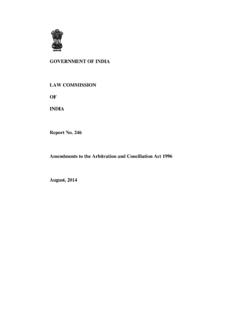Transcription of THE ARBITRATION LAW OF INDIA: A CRITICAL ANALYSIS …
1 THE ARBITRATION LAW OF india : A CRITICAL ANALYSIS . by Sumeet Kachwaha*. [This article was first published in Asia International Arbitrational Journal, Volume 1, Number 2, Pages 105-126]. india opened a fresh chapter in its ARBITRATION laws in 1996 when it enacted the ARBITRATION and Conciliation Act ( the Act' or new Act'). This article presents salient features of the Act and analyses its workings in its near one decade of existence. A. The Pre-1996 Position Prior to 1996, the ARBITRATION law of the country was governed by a 1940 Act. This Act was largely premised on mistrust of the arbitral process and afforded multiple opportunities to litigants to approach the court for intervention. Coupled with a sluggish judicial system, this led to delays rendering arbitrations inefficient and unattractive. A telling comment on the working of the old Act can be found in a 1981 judgment of the Supreme Court where the judge (Justice DA Desai) in anguish remarked the way in which the proceedings under the (1940) Act are conducted and without an exception challenged in Courts, has made lawyers laugh and legal philosophers weep '.
2 B. A New Act, A New Beginning india (in the good company of several other nations) enacted its new ARBITRATION Act based on the United Nations Commission on International Trade Law Model Law on International Commercial Arbitration2 and the ARBITRATION Rules of the United Nations Commission on International Trade Law This was in January 1996. The Statement of Objects and Reasons to the Act made no bones of the inefficiency of the old legislation. It said that the same had become outdated' and there was need to have an Act more responsive to contemporary requirements'. It added: Our economic reforms may not become fully effective if the law dealing with settlement of both domestic and international commercial disputes remains out of tune.'. Amongst the main objectives of the new Act (set out in the Statement of Objects and Reasons) are to minimize the supervisory role of courts in the arbitral process' and to provide that every final arbitral award is enforced in the same manner as if it were a decree of the Court'.
3 This is how the Supreme Court dwelled on the new Act: To attract the confidence of International Mercantile community and the growing volume of india 's trade and commercial relationship with the rest of the world after the new liberalization policy of the Government, Indian Parliament was persuaded to enact the ARBITRATION & Conciliation Act of 1996 in UNCITRAL model and therefore in interpreting any provisions of the 1996 Act Courts must not ignore the objects and purpose of the enactment of 1996. A bare comparison of different provisions of the ARBITRATION Act of 1940 with the provisions of ARBITRATION & Conciliation Act, 1996 would unequivocally indicate that 1996 Act limits intervention of Court with an arbitral process to the C. The Scheme of the Act The Act is a composite piece of legislation. It provides for domestic ARBITRATION , international commercial ARBITRATION , enforcement of foreign award and conciliation (the latter being based on the UNCITRAL.)
4 Conciliation Rules of 1980). The more significant provisions of the Act are to be found in Parts I and II thereof. Part I contains the provisions for domestic and international commercial ARBITRATION . Any ARBITRATION to be conducted in india would be governed by Part I, irrespective of the nationalities of the parties. Part II provides for enforcement of foreign awards. Part I is more comprehensive and contains extensive provisions based on the Model Law. It provides, inter alia, for arbitrability of disputes, nonintervention by courts, composition of the arbitral tribunal, jurisdiction of the arbitral tribunal, conduct of the ARBITRATION proceedings, recourse against arbitral awards and enforcement. Part II, on the other hand, is largely restricted to enforcement of foreign awards governed by the Convention on the Recognition and Enforcement of Foreign Arbitral Awards5 or the Convention on the Execution of Foreign Arbitral Part II is thus, (by its very nature) not a complete code.
5 This led to judicial innovation by the Supreme Court in the case of Bhatia International v Bulk Here the Indian court's jurisdiction was invoked by a party seeking interim measures of protection in relation to an ARBITRATION under the Rules of ARBITRATION of the International Chamber of Commerce International Court of Arbitration8 to be conducted in Paris. The provision for interim measure (s 9) was to be found in Part I alone (which applies only to domestic ARBITRATION ). Hence, the court was faced with a situation where there was no proprio vigore legal provision under which it could grant interim measures of protection. Creatively interpreting the Act, the Supreme Court held that the general provisions' of Part I would apply also to offshore arbitrations, unless the parties expressly or impliedly exclude applicability of the same. Hence, by judicial innovation, the Supreme Court extended the general provisions of Part I to foreign arbitrations as well.
6 It may be stated that this was premised on the assumption that the Indian courts would otherwise have jurisdiction in relation to the matter (in the international sense). This became clear in a subsequent decision of the Supreme Court in Shreejee Traco (I) Pvt Ltd v Paperline International Here the court's assistance was sought for appointing an arbitrator in a foreign ARBITRATION . The power of appointment by the court exists under s 11 of Part I of the Act (which applies to domestic ARBITRATION alone). The court declined to exercise jurisdiction. It found that the ARBITRATION was to be conducted in New York and that the law governing the ARBITRATION proceedings would be the law of seat of the ARBITRATION . Hence, the extension of Part I provisions to foreign arbitrations sanctified byBhatia10 would not be resorted to in every case. The Indian courts would have to first determine if it has jurisdiction, in the international sense.
7 D. Salient Features of the Act The Act applies to all types of arbitrations, viz statutory or non-statutory, institutionally administered or ad hoc, the only qualification being that the dispute must be The salient features of the Act are discussed below. 1. ARBITRATION Agreement Defined An ARBITRATION agreement has to be in writing, and may be even contained in an exchange of letters or any other means of telecommunication which provide a record of the agreement. The agreement need not be signed and the unsigned agreement affirmed by the parties' conduct would be valid as an ARBITRATION An ARBITRATION agreement would also be considered to be in writing if there is an exchange of a statement of claim and defence in which the existence of the agreement is alleged by one party and not denied by the 2. Arbitrability of Disputes The Act states that the relationship between the parties need not be contractual.
8 Hence, a dispute in tort can also be referred. The Supreme Court in the case of Renu Sagar Power Co v General Electric Co14. stated this as follows: The question is not whether the claim lies in tort but the question is whether even though it has lain in tort it arises out of' or is related to' the contract, that is to say, whether it arises out of the terms of the contract or is consequential upon any breach thereof. The court in Renu Sagar I also approved an English decision in the case of Woolf v Collis Removal Service15 where the Court of Appeal held that though the claim in negligence was a claim in tort and not under contract, yet there was a sufficiently close connection between that claim and the transaction to bring the claim within the ARBITRATION clause. Citing this, the court in Renu Sagar I continued: this authority clearly shows that even though a claim may not directly arise under the contract which contains an ARBITRATION clause, if there was sufficient close connection between that claim and the transaction under the contract, it will be covered by the ARBITRATION clause.
9 Hence, whether an action lies in tort or contract, it would lie before an arbitral forum, unless it can be demonstrated that the cause of action is de hors the contract which contains the ARBITRATION clause. A controversy arose as to whether arbitrators would have jurisdiction to order specific performance of a contract. The High Court of Delhi held16 that the power to grant specific performance is discretionary and statutorily conferred on civil courts under the Specific Relief Act 1963. Hence, an arbitral tribunal would have no such power. On the other hand, the High Courts of Punjab, Bombay and Calcutta17 took the view that arbitrators could grant specific performance. The Supreme Court put to rest the controversy in Olympus Superstructures Pvt Ltd v Meena V ay Khetan18 and held that arbitrators do have the power to order specific performance of a contract. The court relied on Halsbury's Laws of England19 which states that the differences or disputes which may be referred must consist of a justifiable issue triable civilly.
10 A fair test of this is whether the difference can be compromised lawfully by way of accord and satisfaction.'. In the case of Hindustan Petroleum Corporation v Pink City,20 the respondent resisted ARBITRATION on the ground that the cause of action made out by the claimant (ie short delivery and tampering with weights and measures and seals) was essentially a criminal offence under special statutes. It was contended that the respondent's conduct could be investigated only by officers so authorised under statute and that the offence, if any, can be tried only by a court of competent jurisdiction and not by an arbitrator. The Supreme Court negatived this contention, holding that the claimant had rights under the contract which are independent of the statutory provisions and hence the contractual rights could be enforced through the ARBITRATION process: The existence of dual procedure; one under the criminal law and the other under the contractual law is a well-accepted legal phenomenon in Indian jurisprudence.








